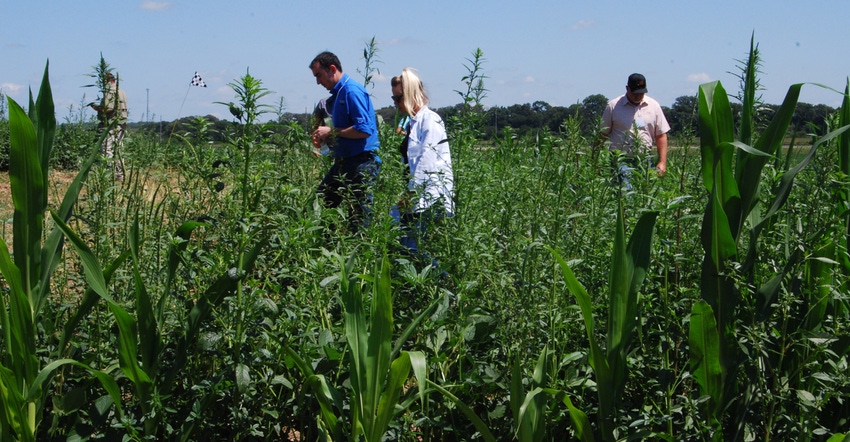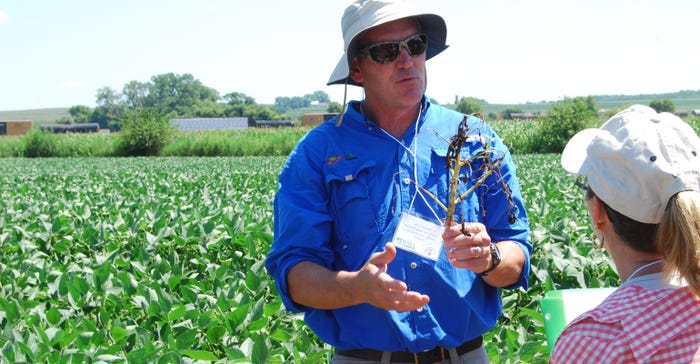December 31, 2019

Pest resistance is a threat to farm profitability. Tools to manage pests and their continued effectiveness support long-term profitability. Those tools include herbicides, insecticides and fungicides, as well as genetic traits introduced into corn hybrids and soybean varieties. In Iowa and the U.S., increasing pest resistance to these tools is outpacing the development of new pest management technologies.
The adoption of resistance management practices has been slow. To deal with this issue, the Iowa Pest Resistance Management Program was established to support teams of farmers, their advisers and other members of the ag community in finding local solutions to pest resistance. The focus is delaying the spread of resistance to protect farm profitability.
Mike Witt, Iowa State University Extension field agronomist, says the goal of IPRMP is to slow the development of resistance in weeds, insects and diseases; focus on early detection of resistance; and mitigate resistance when it does arise.
Collaboration critical
The plan is focused on mobile pests that can move from farm to farm and is based on local collaborative groups working together to share information on pest issues, the threat of resistance, and how best to delay its development and spread.
Achieving that goal will require a consistently coordinated effort across all ag sectors: farmers, crop advisers, chemical and seed companies, university specialists, etc. The program acknowledges the challenges and obstacles farmers face when making pest management choices, and its recommendations are based on the most up-to-date science.
While similarities exist in the general principles of pest resistance management, each type of pest (weed, insect, disease) poses different challenges. Thus, the initial goal for the program is to focus on four pilot projects with different pest targets in several Iowa locations:
resistant weeds in western Iowa
waterhemp in central Iowa
western corn rootworm in northeast Iowa
soybean aphid in northwest Iowa
Of these projects, the Harrison County pilot in western Iowa is the most advanced, with a team that has been active since 2017.
“The team’s first activity was to create and distribute a postcard survey to gauge grower awareness, interest and management practices related to weed resistance,” says Witt, a member of the Harrison County team.
In 2018 and 2019, the team prepared weed management field trials to show the effects of different management programs, which include various pre- and post-management options. Weeds that persisted in the field at the end of the season were screened for resistance to identify specific issues farmers in the county face.
Creating more awareness
Much of the team’s focus has been on creating awareness of the issue. It held three field days in Harrison County so far and gave a presentation at the U.S. Environ-mental Protection Agency’s Nebraska-Iowa herbicide information tour in 2018.
In August, the team hosted plot tours and a two-day meeting with representatives of the Weed Science Society of America and the Entomological Society of America. They discussed pest resistance management and policy options to control the threat to crop production.
Building on success
Now that the Harrison team is established, the next step is to grow the effort. “This is our focus in 2020,” says Larry Buss, a Harrison County farmer and team leader. “The goal of the IPRMP is to have several active projects like ours in Iowa.”
In 2019, the success of the Harrison County pest resistance management project was recognized on a national scale. The team hosted 70 participants from across the U.S. who came to view the plots, and learn how the project began and what makes it successful.
The two-day meeting in August included the Weed Science and Entomological Society representatives, university researchers, seed and pesticide company people, and other pest management professionals. Representatives of commodity groups, EPA and other agencies and organizations attended. This Iowa event demonstrated there is interest in implementing similar pest resistance management efforts in other states.
A major finding of the IPRMP is that socio-economic factors affect how and why some community-based groups readily form. In 2019, the program was awarded a three-year grant from USDA to assess a continued focus on advancing the four pilot projects.
What is pest management?
The Iowa Pest Resistance Management Program is a different approach to pest management. “Pest resistance is not about you. It is about us: Everyone working together as an agricultural community to solve the problem,” Witt says.
The program provides information about pest resistance and increases awareness. One of the goals is to help people understand the problem and get rid of the “ostrich syndrome.”

FIELD DAY: John Swalwell, agronomist with Asgrow/Dekalb on the Harrison County pest resistance managment team, was one of the team members who answered questions at last summer’s plot tour.

“Some folks say, ‘I don’t have pest resistance on my farm. It’s not there.’ However, “everyone needs to accept that pest resistance is a reality,” Witt says. “It is a problem. Whether you have it in your fields today, or even if you don’t, you can easily have it in five, 10 or 15 years. It can come faster than you realize. Some farmers have it in their fields now who a few years ago were saying, ‘We don’t have pest resistance.’ ”
Pest resistance management is an effort to slow down the evolution of pest adaptation, Buss says. It’s not eliminating pest resistance; it’s not saying pest resistance isn’t going to happen.
“We need to slow down its development. Also, note that IPRMP is a voluntary program. We must accept there is a pest resistance problem. We need to work together to deal with it. We want to promote broad adaptation of pest resistance management to preserve the viability of the various methods of controlling crop pests.”
When IPRMP planning got started, roughly in 2015, farmers, ISU Extension, industry representatives, the Iowa Department of Agriculture and others came together and agreed on the need to get the awareness program running. They came up with the four pilot projects.
In 2019, the Harrison County project expanded to include fungicide resistance, in addition to focusing on weed resistance to herbicides. A comparison of fungicide treatments is planned for field trials starting in 2020. Results of the various herbicide systems evaluated for weed control in both no-till and tillage trials are on the Harrison County project’s webpage.
About the Author(s)
You May Also Like






